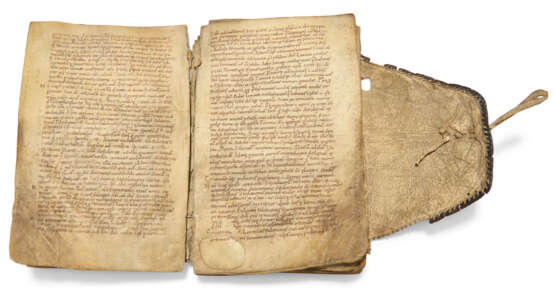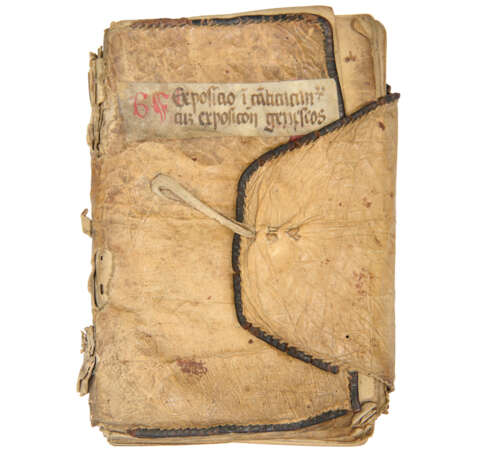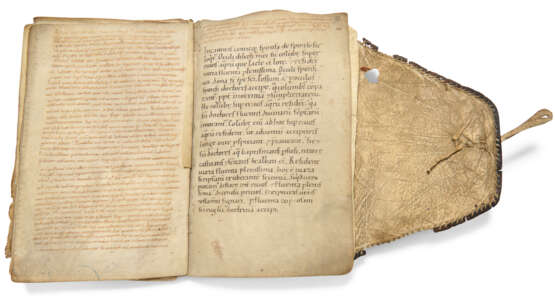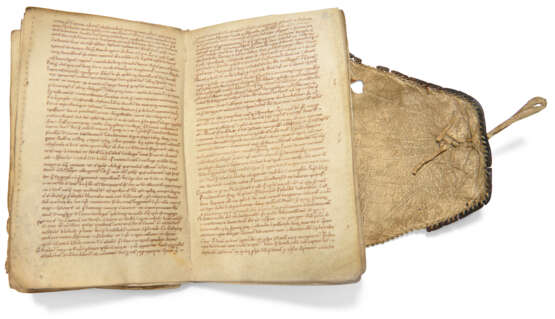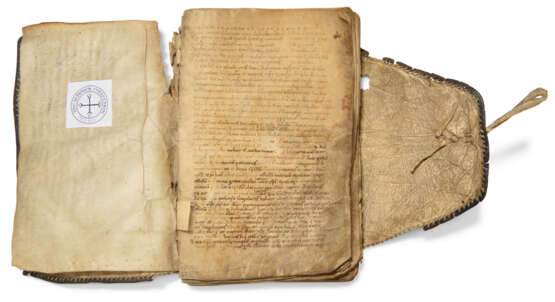ID 1214891
Lot 6 | Haimo of Auxerre (d. c.865)
Estimate value
£ 70 000 – 100 000
Commentarium in Cantica canticorum; Latin, manuscript on vellum [Germany, late 10th?/11th century]
An early monastic copy of an influential biblical commentary in a wallet binding.
180 x 120 mm. 30 leaves: i + 1-28, 37(of 8, lacking v), 47(of 6 + added half leaf after ii) + ii, the endleaves a reused folio, 41-43 lines, prickings for 42 lines, ruled in blind with words overlapping to left, written space: c.150 x 90mm, red initial, sign of cross and touches to capital on folio used as endleaves (reinforcing of worn text f.1, staining into text lower corners ff.1-16, lower corners lost ff.2 and 4, hole into text f.13, early stitched repair to upper corner of f.19, some original holes and flaws in vellum, one of inks used very faded, a few small pencilled marks by text).
Binding:
14th- or 15th-century limp goatskin wallet binding, sewn on three thongs, stitched leather guards over edges, flap with leather securing loop, vellum label on upper cover: Exposicio in canticum canticorum cum exposicione geneseos (upper joint split at top and holed, terminal of top thong lost, leather edgings lost at spine, hole in flap, lacking fastener for securing loop, generally worn). Half morocco box.
Provenance:
(1) The form of the Carolingian minuscule indicates an origin in Germany, probably in a monastery or religious community. More than one hand seems to have contributed and it was clearly intended as an economical working copy. An earlier cataloguer had described it as 9th century, and there are similarities in script with an early manuscript of Haimo's Sermones datable to the 10th/11th century at St Gallen, Cod. Sang. 333. The desire to save parchment is most evident in the opening poem where the last lines are economically written in the space to the right. It may have stayed with the same community: when given its wallet binding, a leaf from an unwanted missal with the proper for St Leonard (6 Nov) was used for the endleaves.
(2) Swann Galleries, New York, 22 March 1990, lot 128, acquired by:
(2) The Schøyen Collection, MS 611.
Content:
Suffrage to St Leonard, headed Missa de Sancto Leonardo confessore, in first endleaf, top half of folio; headed in capitals Incipit tractatus canticorum, followed by Alcuin (c.735-804), carmen 78, opening: 'Hunc cecinit Salemon mira dulcedine librum' (E. Dümmler, Poetae Latini aevi Carolini, I, 1881, p.299), '[O]sculetur me osculo oris sui, Salomon inspiratus divino spiritu composuit hunc libellum [...], ending [...] christi bonus odor sumus deo, in omni loco' (Patrologia latina, CXVII, cols 295 358, as by Haimo of Halberstadt from the Eucharius Cernicon edition, Cologne, 1529).
Many manuscripts of this influential commentary on the Song of Songs are anonymous, like the Schøyen copy, so that attributions over the centuries have ranged from the 5th-century Cassiodorus to the 13th-century Thomas Aquinas. Modern scholarship is agreed that the work should be credited to the Benedictine Haimo of Auxerre, active from the 830s until his death c.865 as abbot of Cessy-les-Bois, a dependence of the Abbey of St Germain at Auxerre, which was a leading centre of scholarship, particularly of Biblical exegesis. The confusions over authorship arose at an early date when many of his works were given to Haimo, Bishop of Halberstadt (d.853) or, occasionally, to the later master at the Auxerre school, Remigius of Auxerre (c.841-908). Haimo of Auxerre also wrote on the Apocalypse, the biblical book most in need of interpretation after the erotic love poem of the Song of Songs, some of the prophets and Genesis. It could have been his commentary on Genesis that once formed part of this volume. Haimo’s commentary on the Song of Songs, an interpretation concentrating on the mystical union between Christ and the Church, drew on earlier works by Bede and Alcuin to produce a clear text that demonstrated the fourfold exegesis of the Bible: literal, allegorical, moral and anagogical. Only some copies have the poem by Alcuin as an introdution. If part of Haimo’s original, it may have been a conscious tribute. The directness of Haimo’s text was ideally suited to teaching and his Commentary proved immensely successful: ‘no other Song of Songs commentary was so widely available in medieval libraries’ (E.A. Matter, The Voice of my Beloved, The Song of Songs in Western Medieval Christendom, 1990, p.37).
The Schøyen copy is a very significant addition to the 130 surviving manuscript copies listed by R. Guglielmetti (La tradizione manoscritta dei commenti latini al Cantico dei cantici (origini-XII secolo), 2006) since only twenty of them date from before the 12th century. The surviving earlier manuscripts originated in Germany, the source of the Schøyen copy, but the accidents of survival do not reflect how Haimo’s Commentary was studied all over Europe. Its popularity and wide dissemination through the schools of western Christendom have resulted in a complicated textual tradition; there is no modern edition. Further research would clarify how the Schøyen copy relates to the three main recensions distinguished by B. van N. Edwards (‘From script to print: manuscripts and printed editions of Haimo’s Commentary on the Song of Songs’, S. Shimahara ed., Études d'exégèse carolingienne : autour d'Haymon d'Auxerre, 2007, pp.59-85).
| Place of origin: | Western Europe, Germany, Europe |
|---|---|
| Auction house category: | Medieval & renaissance manuscripts, Books and manuscripts |
| Place of origin: | Western Europe, Germany, Europe |
|---|---|
| Auction house category: | Medieval & renaissance manuscripts, Books and manuscripts |
| Address of auction |
CHRISTIE'S 8 King Street, St. James's SW1Y 6QT London United Kingdom | |
|---|---|---|
| Preview |
| |
| Phone | +44 (0)20 7839 9060 | |
| Buyer Premium | see on Website | |
| Conditions of purchase | Conditions of purchase |
